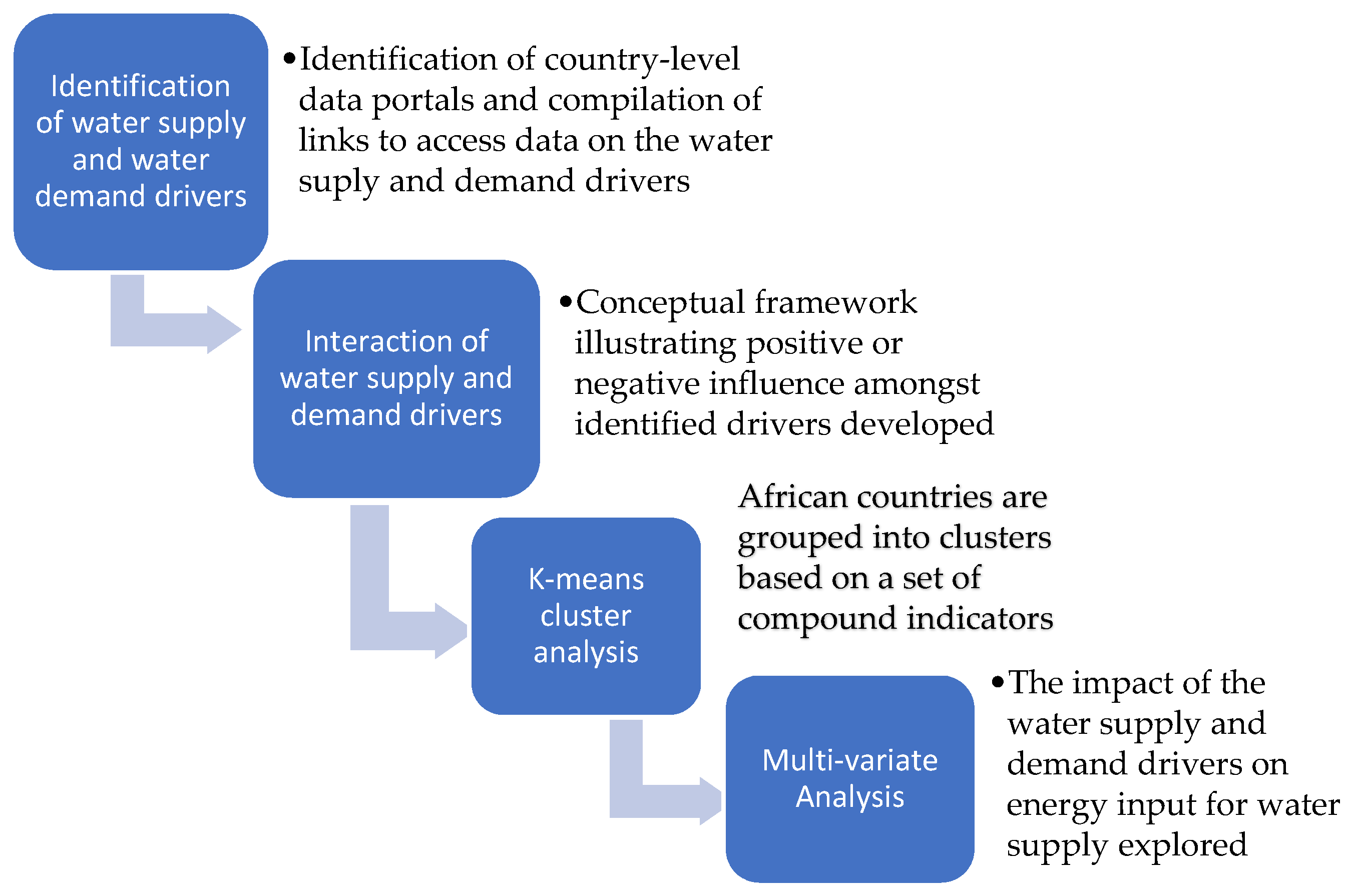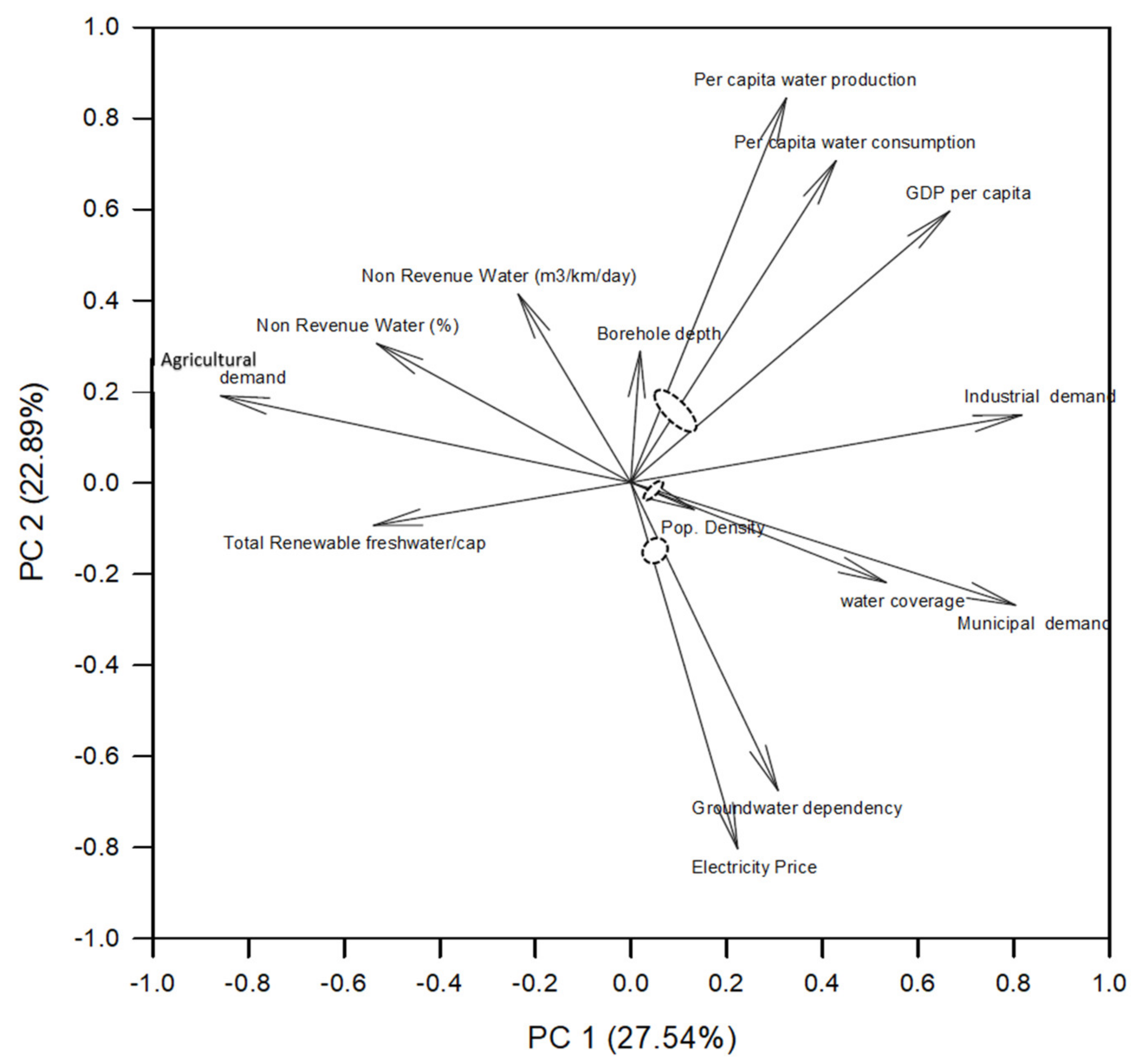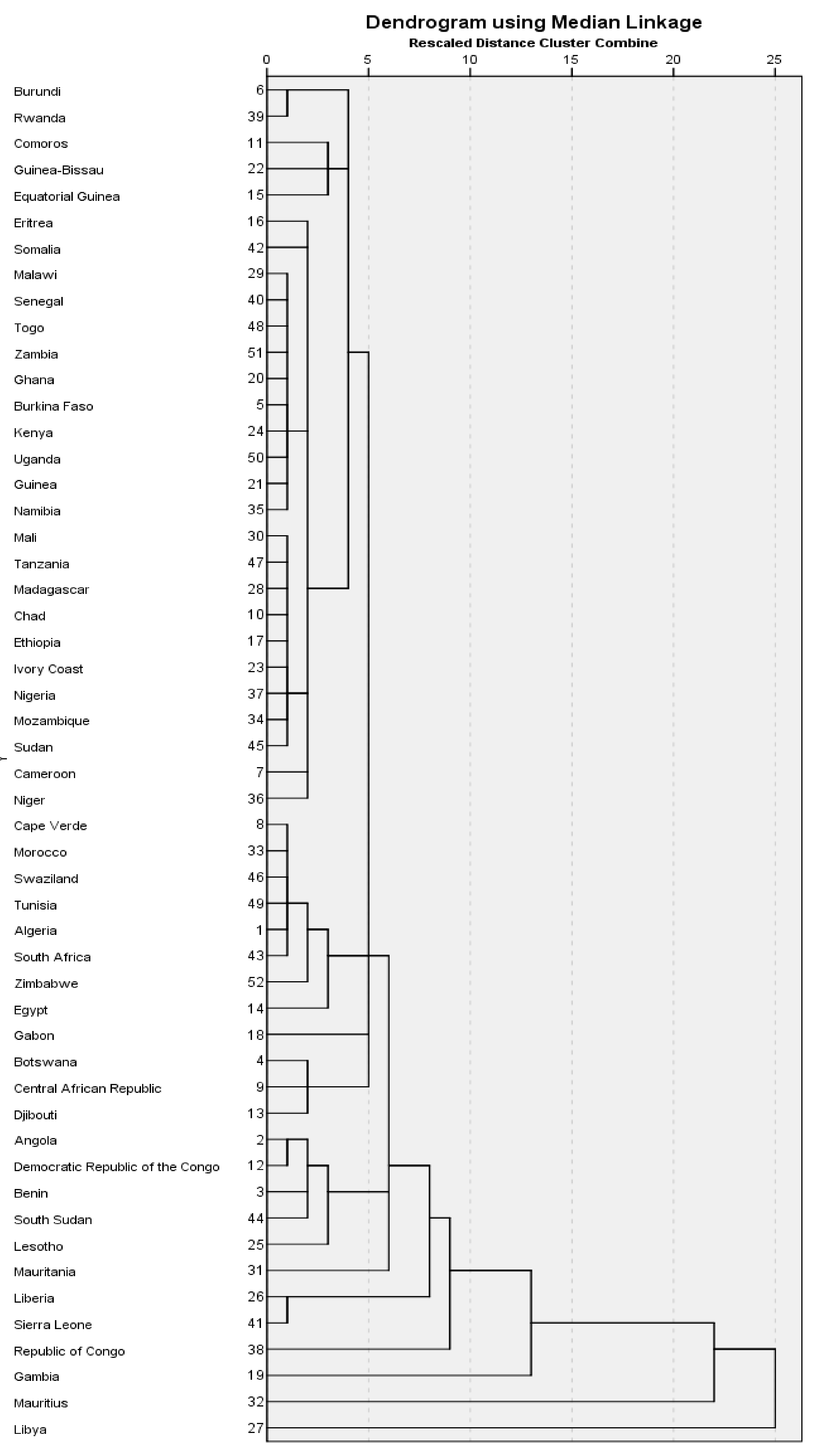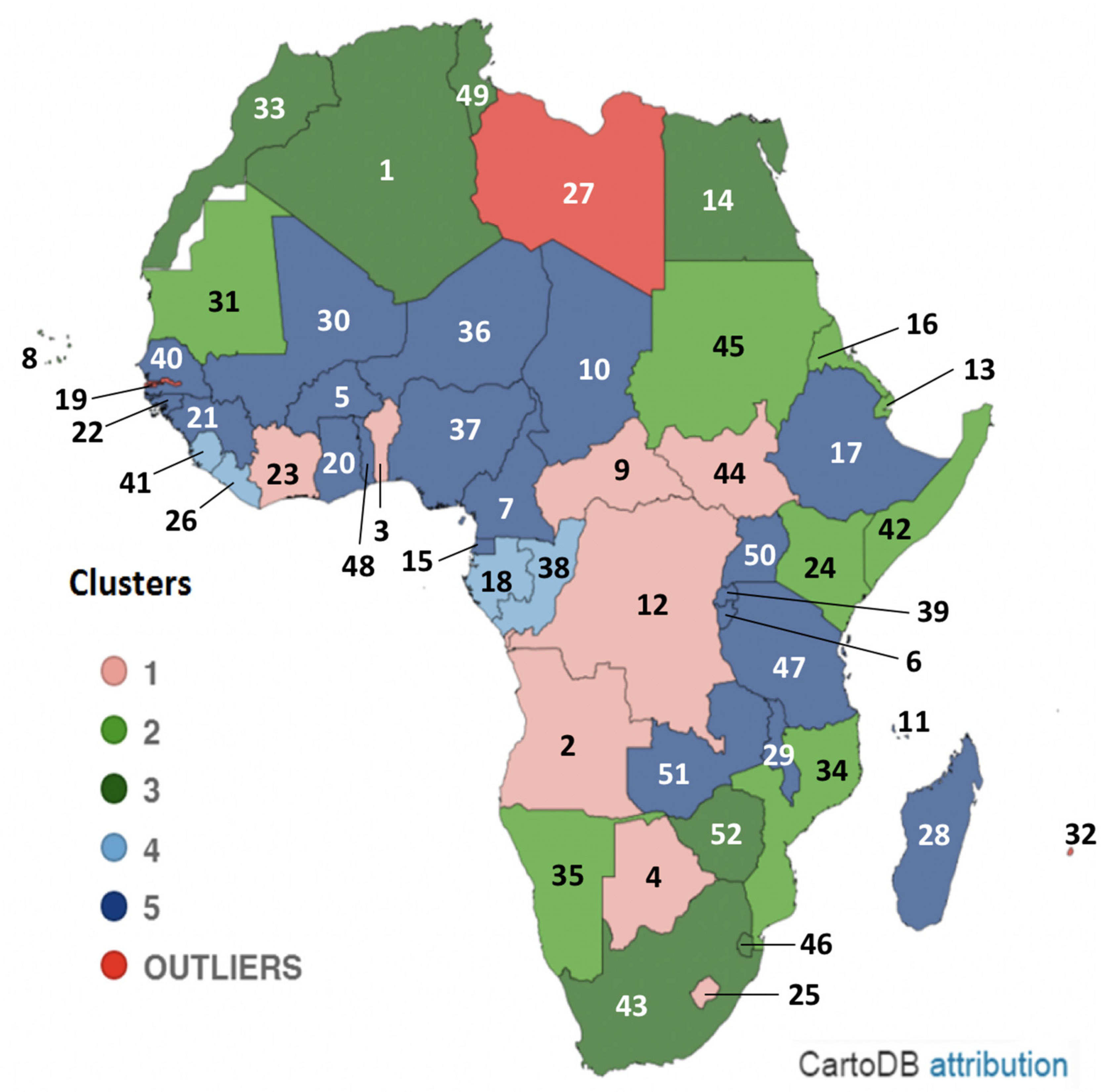Examining the Relative Impact of Drivers on Energy Input for Municipal Water Supply in Africa
Abstract
:1. Introduction
Approach of the Study
2. Materials and Methods
2.1. Parameterization of Indicators
- Drivers affecting freshwater availability (water quantity):
- 2.
- Drivers affecting freshwater availability (water quality):
- 3.
- Utility operations directly impacting energy input for municipal water supply:
2.2. Developing the Conceptual Flow Model and Generating Impact Scores
2.2.1. Generating Impact Scores to Compare Countries within a Reference Group
2.2.2. Compound Indicators Affecting Freshwater Availability by Impact on Water Quantity
2.2.3. Compound Indicators Affecting Freshwater Availability by Impact on Water Quality
2.2.4. Compound Indicators Affecting Municipal Water Demand
2.3. Impact Analysis of Parameterized Indicators for Water Security Clusters
3. Results
3.1. Supply-Side and Demand-Side Drivers of Municipal Water Supply
3.2. Interactions between Supply-Side and Demand-Side Drivers
3.3. Relative Impact of Demand-Side and Supply-Side Drivers on Energy Input
3.4. Cluster Centers with Identical Compound Indicators and Impacts Scores for African Countries
4. Discussion
5. Conclusions
Supplementary Materials
Author Contributions
Funding
Institutional Review Board Statement
Informed Consent Statement
Data Availability Statement
Conflicts of Interest
Abbreviations
| ACCSAN | Access to improved sanitation facilities |
| AQUASTAT | The Food and Agriculture Organization global information system on water resources and agricultural water management. |
| AGRV | Annual growth rate of agricultural value-added |
| AfDB | African Development Bank |
| CWD | Per capita water demand |
| CWR | Municipal water losses |
| IBNET | International benchmarking Network for Water and Sanitation Utilities |
| IND | Net annual industrial production growth |
| GWD | Groundwater dependency |
| PDEN | Population density |
| STAN | subSTance flow Analysis |
| SWGWDEP | Relative dependency on surface and groundwater |
| UPG | Urban population growth |
| WEF | World Economic Forum |
| WQ | Water quality |
| WQA | Impact of agricultural production on freshwater quality |
| WQI | Impact of industrial production on freshwater quality |
| WWM | Wastewater management |
| WWTRT | Proportion of wastewater that is treated |
| YCELP | Yale Center for Environmental Law and Policy |
References
- Wakeel, M.; Chen, B.; Hayat, T.; Alsaedi, A.; Ahmad, B. Energy consumption for water use cycles in different countries: A review. Appl. Energy 2016, 178, 868–885. [Google Scholar] [CrossRef]
- Liu, F.; Ouedraogo, A.; Manghee, S.; Danilenko, A. A Primer on Energy Efficiency for Municipal Water and Wastewater Utilities; ESMAP: Washington, DC, USA, 2012. [Google Scholar]
- Venkatesh, G.; Chan, A.; Brattebø, H. Understanding the Water-Energy-Carbon Nexus in Urban Water Utilities: Comparison of Four City Case Studies and the Relevant Influencing Factors. Energy 2014, 75, 153–166. [Google Scholar] [CrossRef]
- McDonald, R.I.; Green, P.; Balk, D.; Fekete, B.M.; Revenga, C.; Todd, M.; Montgomery, M. Urban growth, climate change, and freshwater availability. Proc. Natl. Acad. Sci. USA 2011, 108, 6312–6317. [Google Scholar] [CrossRef] [Green Version]
- Bazilian, M.; Rogner, H.; Howells, M.; Hermann, S.; Arent, D.; Gielen, D.; Steduto, P.; Mueller, A.; Komor, P.; Tol, R.S.J.; et al. Considering the Energy, Water and Food Nexus: Towards an integrated modelling approach. Energy Policy 2011, 39, 7896–7906. [Google Scholar] [CrossRef]
- Yillia, P. Water-Energy-Food Nexus: Framing the Opportunities, Challenges and Synergies for Implementing the SDGs. Osterr. Wasser Abfallwirtsch. 2016, 68, 86–98. [Google Scholar] [CrossRef]
- IEA. Electricity Information 2020. International Energy Agency (IEA). 2020. Available online: https://www.iea.org/data-and-statistics/data-browser/?country=BOTSWANA&fuel=Energy%20supply&indicator=ElecGenByFuel (accessed on 8 May 2021).
- Richards, B.S.; Shen, J.; Schäfer, A.I. Water–Energy Nexus Perspectives in the Context of Photovoltaic-Powered Decentralized Water Treatment Systems: A Tanzanian Case Study. Energy Technol. 2017, 5, 1112–1123. [Google Scholar] [CrossRef] [Green Version]
- Burek, P.; Satoh, Y.; Fischer, G.; Kahil, M.T.; Scherzer, A.; Tramberend, S.; Nava, L.F.; Wada, Y.; Eisner, S.; Flörke, M.; et al. Water Futures and Solution, Fast Track Initiative—Final Report ADA Project Number 2725-00/2014. In IIASA Working Paper WP-16-006; International Institute for Applied Systems Analysis: Laxenburg, Austria, 2016. [Google Scholar]
- Eberhard, R. Access to Water and Sanitation in Sub-Saharan Africa: Review of Sector Reforms and Investments, Key Findings to Inform Future Support to Sector Development. 2019. Available online: http://www.giz.de (accessed on 5 January 2021).
- WHO/UNICEF. Progress on Household Drinking Water, Sanitation and Hygiene 2000–2020. Five Years into the SDGs; World Health Organization (WHO); United Nations Children’s Fund (UNICEF) Joint Monitoring Program: Geneva, Switzerland, 2021; Available online: https://un-water.org/publications/who-unicef-joint-monitoring-program-for-water-supply-sanitation-and-hygiene-2000-2020 (accessed on 12 July 2021).
- Lubega, W.N.; Farid, A.M. A Reference System Architecture for the Energy-Water Nexus. IEEE Syst. J. 2014, 99, 1–11. [Google Scholar] [CrossRef]
- Santhosh, A.; Farid, A.M.; Youcef-Toumi, K. Real-Time Economic Dispatch for the Supply Side of the Energy-Water Nexus. Appl. Energy 2014, 122, 42–52. [Google Scholar] [CrossRef]
- UN-DESA. World Population Prospects 2019, Volume I: Comprehensive Tables; Department of Economic and Social Affairs (UN-DESA); ECOSOC: New York, NY, USA, 2019; Available online: https://www.un.org/en/development/desa/population/publications/database/index.asp (accessed on 10 March 2021).
- Stoker, P.; Rothfeder, R. Drivers of urban water use. Sustain. Cities Soc. 2014, 12, 1–8. [Google Scholar] [CrossRef]
- Garcia, M.; Islam, S. The role of external and emergent drivers of water use change in Las Vegas. Urban Water J. 2018, 15, 888–898. [Google Scholar] [CrossRef] [Green Version]
- Barker, A.; Pitman, A.; Evans, J.P.; Spaninks, F.; Uthayakumaran, L. Drivers of future water demand in Sydney, Australia: Examining the contribution from population and climate change. J. Water Clim. Chang. 2021, 12, 1168–1183. [Google Scholar] [CrossRef]
- Lee, M.; Keller, A.A.; Chiang, P.C.; Den, W.; Wang, H.; Hou, C.H.; Wu, J.; Wang, X.; Yan, J. Water-energy nexus for urban water systems: A comparative review on energy intensity and environmental impacts in relation to global water risks. Appl. Energy 2017, 205, 589–601. [Google Scholar] [CrossRef] [Green Version]
- Wu, W.; Maier, H.R.; Dandy, G.C.; Arora, M.; Castelletti, A. The changing nature of the water–energy nexus in urban water supply systems: A critical review of changes and responses. J. Water Clim. Chang. 2020, 11, 1095–1122. [Google Scholar] [CrossRef]
- Mamade, A.; Loureiro, D.; Alegre, H.; Covas, D. A comprehensive and well tested energy balance for water supply systems. Urban Water J. 2017, 14, 853–861. [Google Scholar] [CrossRef]
- Loureiro, D.; Alegre, H.; Silva, M.S.; Ribeiro, R.; Mamade, A.; Poças, A. Implementing tactical plans to improve water-energy loss management. Water Sci. Technol. Water Supply 2017, 17, 381–388. [Google Scholar] [CrossRef]
- Elimelech, M.; Phillip, W.A. The Future of Seawater Desalination: Energy, Technology, and the Environment. Science 2011, 333, 712–717. [Google Scholar] [CrossRef]
- Shatat, M.; Worall, M.; Riffat, S. Opportunities for Solar Water Desalination Worldwide: Review. Sustain. Cities Soc. 2013, 9, 67–80. [Google Scholar] [CrossRef]
- FAO-AQUASTAT. FAO’s Global Information System on Water and Agriculture. FAO. 2021. Available online: http://www.fao.org/aquastat/databases (accessed on 2 March 2021).
- World Bank. Getting Electricity: Price of Electricity (US Cents per kWh) (DB16-20 Methodology). Data Catalog. 2021. Available online: http://www.worldbank.org (accessed on 24 April 2021).
- African Development Bank Group (AfDB) Data Portal. 2021. Available online: https://dataportal.opendataforafrica.org/bbkawjf/afdb-socio-economic-database-1960-2019 (accessed on 29 February 2021).
- Malve, O.; Tattar, S.; Riihimäki, J.; Jaakkola, E.; Voβ, A.; Williams, R.; Bärlund, I. Estimation of diffuse pollution loads in Europe for continental scale modelling of loads and in-stream river water quality. Hydrol. Process. 2012, 26, 2385–2394. [Google Scholar] [CrossRef] [Green Version]
- Reder, K.; Bärlund, I.; Voß, A.; Kynast, E.; Williams, R.; Malve, O.; Flörke, M. European scenario studies on future in-stream nutrient concentrations. Trans. ASABE 2013, 56, 1407–1417. [Google Scholar]
- Reder, K.; Malsy, M.; Bärlund, I.; Flörke, M. Modelling Water Pollution Posing a Risk to Human and Ecosystem Health in Africa Using FC and BOD as Indicator Substances. WIT Trans. Ecol. Environ. 2014, 182, 297–308. [Google Scholar]
- Voß, A.; Alcamo, J.; Bärlund, I.; Voß, F.; Kynast, E.; Williams, R.; Malve, O. Continental Scale Modelling of in-Stream River Water Quality: A Report on Methodology, Test Runs, and Scenario Application. Hydrol. Process. 2012, 26, 2370–2384. [Google Scholar] [CrossRef] [Green Version]
- Williams, R.; Keller, V.; Voß, A.; Bärlund, I.; Malve, O.; Riihimäki, J.; Sirkka, T.; Alcamo, J. Assessment of current water pollution loads in Europe: Estimation of gridded loads for use in global water quality models. Hydrol. Process. 2012, 26, 2395–2410. [Google Scholar] [CrossRef] [Green Version]
- YCELP, CIESIN, and WEF. Environmental Performance Index (EPI). NASA Socioeconomic Data and Applications Center (SEDAC). 2014. Available online: http://sedac.ciesin.columbia.edu/ (accessed on 30 April 2021).
- Leclerc, G.; Cros, B.; Rojot, C.; Koskas, J.; Ndombo, J.; Raes, T. Water: Challenges, Drivers and Solutions. Pricewaterhouse Coopers. 2012. Available online: https://www.pwc.com/gx/en/sustainability/publications/assets/pwc-water-challenges-drivers-and-solutions.pdf (accessed on 30 April 2021).
- Sood, A.; Smakhtin, V. Global Hydrological Models: A Review. Hydrol. Sci. J. 2014, 60, 549–565. [Google Scholar] [CrossRef]
- Padowski, J.C.; Gorelick, S.M.; Thompson, B.H.; Rozelle, S.; Fendorf, S. Assessment of Human–natural System Characteristics Influencing Global Freshwater Supply Vulnerability. Environ. Res. Lett. 2015, 10, 104014. [Google Scholar] [CrossRef]
- IBNET. Benchmarking Database, International Benchmarking Network for Water and Sanitation Utilities (IBNET). 2021. Available online: http://www.ib-net.org/) (accessed on 10 March 2021).
- Pavelic, P.; Giordano, M.; Keraita, B.; Ramesh, V.; Rao, T. Groundwater Availability and Use in Sub-Saharan Africa: A Review of 15 Countries; International Water Management Institute (IWMI): Colombo, Sri Lanka, 2012; 274p. [Google Scholar] [CrossRef] [Green Version]
- Serele, C.; Pérez-Hoyos, A.; Kayitakire, F. Mapping of groundwater potential zones in the drought-prone areas of south Madagascar using geospatial techniques. Geosci. Front. 2020, 11, 1403–1413. [Google Scholar] [CrossRef]
- Cencic, O.; Rechberger, H. Material Flow Analysis with Software STAN. J. Environ. Eng. Manag. 2008, 18, 5. [Google Scholar]
- Murtagh, F.; Legendre, P. Ward’s Hierarchical Clustering Method: Clustering Criterion and Agglomerative Algorithm. J. Classif. 2014, 31, 274–295. [Google Scholar] [CrossRef] [Green Version]
- NERC. Depth to Groundwater Map. British Geological Survey. Natural Environment Research Council (NERC). 2011. Available online: http://www.bgs.ac.uk/research/groundwater/datainfo/levels/levels_data.html (accessed on 15 May 2021).
- Hashemi, S.; Filion, Y.; Speight, V. Identification of factors that influence energy performance in water distribution system mains. Water 2018, 10, 428. [Google Scholar] [CrossRef] [Green Version]
- Zuśka, Z.; Kopcińska, J.; Dacewicz, E.; Skowera, B.; Wojkowski, J.; Ziernicka-Wojtaszek, A. Application of the principal component analysis (PCA) method to assess the impact of meteorological elements on concentrations of particulate matter (PM10): A case study of the mountain valley (the Sacz Basin, Poland). Sustainability 2019, 11, 6740. [Google Scholar] [CrossRef] [Green Version]
- Jemmali, H. Water Poverty in Africa: A Review and Synthesis of Issues, Potentials, and Policy Implications. Soc. Indic. Res. 2018, 136, 335–358. [Google Scholar] [CrossRef]
- OECD. Organization for Economic Co-operation and Development (OECD) Database. 2021. Available online: https://stats.oecd.org/Index.aspx?QueryId=101141 (accessed on 29 April 2021).
- World Bank. Data. World Development Indicators. 2019. Available online: http://data.worldbank.org/datacatalog/world-development-indicators (accessed on 30 April 2021).
- Haddeland, I.; Heinke, J.; Biemans, H.; Eisner, S.; Flörke, M.; Hanasaki, N.; Konzmann, M.; Ludwig, F.; Masaki, Y.; Schewe, J.; et al. Global Water Resources Affected by Human Interventions and Climate Change. Proc. Natl. Acad. Sci. USA 2014, 111, 3251–3256. [Google Scholar] [CrossRef] [PubMed] [Green Version]
- Iofin, Z.K. Variability of Water Resources and Water Balance. Sustain. Water Resour. Manag. 2015, 1, 155–156. [Google Scholar] [CrossRef] [Green Version]
- Döll, P.; Jiménez-Cisneros, B.; Oki, T.; Arnell, N.W.; Benito, G.; Cogley, J.G.; Jiang, T.; Kundzewicz, Z.W.; Mwakalila, S.; Nishijima, A. Integrating Risks of Climate Change into Water Management. Hydrol. Sci. J. 2014, 60, 4–13. [Google Scholar] [CrossRef] [Green Version]
- Jacobsen, M.; Webster, M.; Vairavamoorthy, K. The Future of Water in African Cities: Why Waste Water? In Directions in Development; World Bank: Washington, DC, USA, 2012. [Google Scholar] [CrossRef]
- Plappally, A.K.; Lienhard, J.H. Energy Requirements for Water Production, Treatment, End Use, Reclamation, and Disposal. Renew. Sustain. Energy Rev. 2012, 16, 4818–4848. [Google Scholar] [CrossRef]
- dos Santos, S.; Adams, E.; Neville, G.; Wada, Y.; de Sherbinin, A.; Mullin Bernhardt, E.; Adamo, S. Urban growth and water access in sub-Saharan Africa: Progress, challenges, and emerging research directions. Sci. Total. Environ. 2017, 607, 497–508. [Google Scholar] [CrossRef]
- Cooley, H.; Wilkinson, R. Implications of Future Water Supply Sources for Energy Demands. Water Reuse Research Foundation 2012. Available online: http://pacinst.org/wp-content/uploads/2013/02/report19.pdf (accessed on 30 April 2021).
- Alcamo, J.; Döll, P.; Henrichs, T.; Kaspar, F.; Lehner, B.; Rösch, T.; Siebert, S. Development and Testing of the WaterGAP 2 Global Model of Water Use and Availability. Hydrol. Sci. J. 2003, 48, 317–337. [Google Scholar] [CrossRef]
- Siddiqi, A.; Anadon, L.D. The Water-Energy Nexus in Middle East and North Africa. Energy Policy 2011, 39, 4529–4540. [Google Scholar] [CrossRef]
- Goga, T.; Friedrich, E.; Buckley, C.A. Environmental life cycle assessment for potable water production—A case study of seawater desalination and mine-water reclamation in South Africa. Water SA 2019, 45, 700–709. [Google Scholar] [CrossRef] [Green Version]
- Lam, K.L.; Kenway, S.J.; Lant, P.A. Energy use for water provision in cities. J. Clean. Prod. 2017, 143, 699–709. [Google Scholar] [CrossRef] [Green Version]
- Bartos, M.D.; Chester, M.V. The conservation nexus: Valuing interdependent water and energy savings in Arizona. Environ. Sci. Technol. 2014, 48, 2139–2149. [Google Scholar] [CrossRef] [PubMed]
- Wada, Y.; Wisser, D.; Bierkens, M.F.P. Global Modeling of Withdrawal, Allocation and Consumptive Use of Surface Water and Groundwater Resources. Earth Syst. Dyn. 2014, 5, 15–40. [Google Scholar] [CrossRef] [Green Version]
- van den Berg, C.; Danilenko, A. Performance of Water Utilities in Africa. 2017. Available online: http://www.worldbank.org/water (accessed on 11 January 2021).
- Ernedal, S.; Vauvert, J.; Moore, N.; Pesambili, L. Energy efficiency in action: GIZ tackles the water-energy nexus in Tanzania. ECEE Summer Study Proc. 2015. Available online: http://www.africaneconomicoutlook.org (accessed on 22 February 2021).
- Cloutier, M.; Rowley, P. The feasibility of renewable energy sources for pumping clean water in sub-Saharan Africa: A case study for Central Nigeria. Renew. Energy 2011, 36, 2220–2226. [Google Scholar] [CrossRef] [Green Version]
- Samora, I.; Manso, P.; Franca, M.J.; Schleiss, A.J.; Ramos, H.M. Energy recovery using micro-hydropower technology in water supply systems: The case study of the city of Fribourg. Water 2016, 8, 344. [Google Scholar] [CrossRef] [Green Version]
- Pérez-Sánchez, M.; Sánchez-Romero, F.J.; Ramos, H.M.; López-Jiménez, P.A. Energy recovery in existing water networks: Towards greater sustainability. Water 2017, 9, 97. [Google Scholar] [CrossRef] [Green Version]
- Molinos-Senante, M.; Sala-Garrido, R. Energy intensity of treating drinking water: Understanding the influence of factors. Appl. Energy 2017, 202, 275–281. [Google Scholar] [CrossRef]
- Grady, C.A.; Weng, S.; Blatchley, E.R. Global Potable Water: Current Status, Critical Problems, and Future Perspectives. In Potable Water; The Handbook of Environmental Chemistry 30; Younos, T., Grady, C.A., Eds.; Springer: Cham, Switzerland, 2014; pp. 37–60. [Google Scholar]
- Kiguchi, M.; Shen, Y.; Kanae, S.; Oki, T. Re-evaluation of Future Water Stress due to Socio-Economic and Climate Factors under a Warming Climate. Hydrol. Sci. J. 2015, 60, 14–29. [Google Scholar] [CrossRef] [Green Version]







| Drivers | Indicators Identified | Units | Quantified | Data Sources |
|---|---|---|---|---|
| Drivers affecting freshwater availability (water quantity and quality) | ||||
| Freshwater availability | Total annual renewable freshwater per capita | m3/capita/yr | √ | [24] |
| Climate forces | Precipitation and potential evapotranspiration | mm/yr | [34,35] | |
| Biophysical exchange | Surface runoff and infiltration | mm/Km2 | [25] | |
| Exploitation of available water resources | Fraction of total annual renewable freshwater abstracted | % | [24] | |
| Relative water source dependency | Ratio of total renewable surface water to total renewable groundwater (scalar fraction) | 109 m3/yr | √ | [24] |
| Storage capacity | Capacity of dams/reservoirs | km3 | [24] | |
| Borehole depth | Median depth of boreholes for groundwater abstraction | mbg | √ | [37,38] |
| Urban sprawl | Built-up area expressed as settled area over a given land area | km2 | [45] | |
| Agricultural water demand | Fraction of total annual withdrawal due to withdrawal by agriculture | % | √ | [24] |
| Livestock densities | Number of livestock per unit area | livestock/km2 | ||
| Industry (manufacturing) water demand | Fraction of total annual freshwater withdrawal by industry (manufacturing) | % | √ | [24] |
| Increase in agricultural activity | Annual growth rate of agricultural value-added | % | [26] | |
| Increase in industrial activity | Annual growth rate of industrial (manufacturing) value-added | % | [26] | |
| Water use efficiency of productive sectors | Water use per unit produced; volume of water reuse/recycled | m3 | ||
| Vulnerability to upstream water abstraction | Total surface water and groundwater entering the country | 109 m3/yr | [26] | |
| Institutional factors/water governance | Government effectiveness, control of corruption, political stability | Governance ratings (%), corruption perception index | [10,46] | |
| Environmental drivers of water quality | Natural increase/decrease in temperature, oxygen, salinity, pH, concentrations of heavy metals, arsenic, fluoride, etc. | |||
| Wastewater treatment | Fraction of wastewater safely treated through treatment processes | % | [32] | |
| Pollution by agriculture | Fraction of freshwater abstraction by agriculture and VA growth | % | [25] | |
| Pollution by industry (manufacturing) | Fraction of freshwater abstraction by industry and VA growth | % | [25] | |
| Increased pollutant discharge | Population density, which reflects regional distribution of pollution across Africa (based on [30]) | population/km2 | √ | [25] |
| Cross-border upstream water pollution | Water quality indicators for freshwater sources beyond the jurisdiction especially Phosphorus and Nitrogen | mg/l | [27,28,29,30] | |
| Demographic factors affecting freshwater water availability (water quantity) | ||||
| Municipal water withdrawal | Total annual demand for municipal water | 109 m3/yr | √ | [25] |
| Population growth | Annual population growth rate | % | √ | [25] |
| Per capita municipal water production and per capita water consumption | Municipal water supplied per capita | l/p/d | √ | [36] |
| Lifestyle change | Annual per capita GDP growth rate | % | [25] | |
| Access to improved water sources | Population with access to improved water sources | % | √ | [36] |
| Water demand management | Household demographic and economic variables | Number of persons, age, daily per capita consumption, and income | [3,15,16,17] | |
| Per capita income | GDP per capita | USD per capita | √ | [25] |
| Operational factors directly impacting energy input for municipal water supply | ||||
| Electricity price (tariffs) | Electricity tariffs (price per kWh) levied on municipal water utilities | USD/kWh | √ | [25] |
| Energy intensity for water supply | Energy needed to deliver a unit of groundwater to the surface and to treat and deliver water from source to end user | kWh/m3 | [1] | |
| Layout of the water supply system | Pumping distance | m | [1,3] | |
| State of water infrastructure | Pipe breaks, pump efficiency | breaks/km/yr % | [25,36] | |
| Water loss in the water distribution system | Proportion of water produced that does not reach consumers | m3/km/day and % Non-Revenue Water (NRW) | √ | [36] |
| Water supply technology | Efficiency of devices and processes, especially pumps and motors used for water production, treatment, and distribution | % Efficiency | [2,20,21,36] | |
| Water Security Category | Total Annual Renewable Freshwater (Tarf) Per Capita * | Municipal Withdrawal (Proportion of Tarf) * | Agricultural Withdrawal (Proportion of Tarf) * | Industrial Withdrawal (Proportion of Tarf) * | GDP Per Capita ** | Water Coverage *** | Per Capita Water Production *** | Per Capita Water Consumption *** | Average Water Loss in Distribution Systems *** | Electricity Price (Tariff) ** | Electricty Cost as a Proportion of Total Operating Cost | Median Depth of Boreholes **** |
|---|---|---|---|---|---|---|---|---|---|---|---|---|
| m3/cap/yr | % | % | % | USD/cap | % | l/p/d | l/p/d | m3/km/day | USD/kWh | % | Mbg | |
| Water-secure | ||||||||||||
| CAR | 30,679 | 83 | 17 | 1 | 945 | 46 | 79 | 39 | 44 | 0.108 | 17 | 15 |
| Eq. Guinea | 20,602 | 80 | 15 | 5 | 18,558 | 72 | 42 | 29 | 33 | 0.217 | λ | 120 |
| Ivory Coast | 3144 | 28 | 52 | 21 | 5212 | 69 | 49 | 37 | 12 | 0.124 | 11 | 58 |
| Mali | 3241 | 2 | 98 | 0 | 2321 | 68 | 116 | 75 | 18 | 0.148 | 17 | 85 |
| Mozambique | 3501 | 25 | 73 | 2 | 1218 | 64 | 131 | 82 | 25 | 0.087 | 9 | 100 |
| Madagascar | 13,179 | 3 | 96 | 1 | 1647 | 90 | 282 | 187 | 30 | 0.146 | λ | 27 |
| Zambia | 4759 | 18 | 73 | 8 | 3470 | 85 | 152 | 61 | 35 | 0.047 | 14 | 70 |
| Water-stressed | ||||||||||||
| Benin | 922 | 31 | 45 | 24 | 3287 | 78 | 51 | 39 | 5.3 | 0.150 | 21 | 15 |
| Ethiopia | 1147 | 6 | 93 | 1 | 2221 | 54 | 127 | 65 | 38.6 | 0.020 | 10 | 165 |
| Ghana | 1040 | 20 | 73 | 6 | 5412 | 80 | 95 | 46 | 42.0 | 0.138 | 26 | 35 |
| Kenya | 412 | 35 | 60 | 5 | 4329 | 56 | 70 | 35 | 50.0 | 0.102 | 13 | 276 |
| Malawi | 913 | 11 | 85 | 4 | 1060 | 77 | 90 | 65 | 18.0 | 0.167 | 9 | 53 |
| Niger | 162 | 30 | 67 | 3 | 1225 | 86 | 75 | 63 | 6.6 | 0.120 | α | 100 |
| Nigeria | 1158 | 40 | 44 | 16 | 5135 | 70 | 98 | 46 | 36.0 | 0.105 | 18 | 220 |
| Rwanda | 793 | 22 | 68 | 10 | 2626 | 78 | 53 | 31 | 7.2 | 0.098 | λ | 35 |
| Senegal | 1673 | 6 | 92 | 2 | 3395 | 98 | 73 | 59 | 9.4 | 0.250 | 40 | 353 |
| South Africa | 786 | 27 | 63 | 11 | 12,482 | 99 | 235 | 190 | 30 | 0.072 | α | 130 |
| Tanzania | 1537 | 9 | 90 | 1 | 2660 | 63 | 119 | 71 | 59.0 | 0.102 | 16 | 110 |
| Uganda | 947 | 51 | 41 | 8 | 2187 | 75 | 72 | 48 | 12.0 | 0.157 | 22 | 45 |
| Zimbabwe | 861 | 12 | 82 | 6 | 2836 | 67 | 101 | 62 | 9.0 | 0.155 | 25 | 90 |
Publisher’s Note: MDPI stays neutral with regard to jurisdictional claims in published maps and institutional affiliations. |
© 2021 by the authors. Licensee MDPI, Basel, Switzerland. This article is an open access article distributed under the terms and conditions of the Creative Commons Attribution (CC BY) license (https://creativecommons.org/licenses/by/4.0/).
Share and Cite
Macharia, P.; Wirth, M.; Yillia, P.; Kreuzinger, N. Examining the Relative Impact of Drivers on Energy Input for Municipal Water Supply in Africa. Sustainability 2021, 13, 8480. https://doi.org/10.3390/su13158480
Macharia P, Wirth M, Yillia P, Kreuzinger N. Examining the Relative Impact of Drivers on Energy Input for Municipal Water Supply in Africa. Sustainability. 2021; 13(15):8480. https://doi.org/10.3390/su13158480
Chicago/Turabian StyleMacharia, Pauline, Maria Wirth, Paul Yillia, and Norbert Kreuzinger. 2021. "Examining the Relative Impact of Drivers on Energy Input for Municipal Water Supply in Africa" Sustainability 13, no. 15: 8480. https://doi.org/10.3390/su13158480







